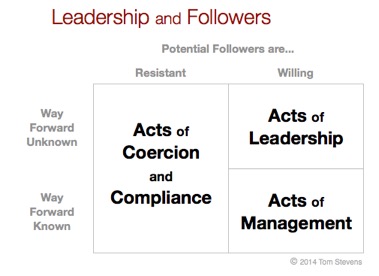Followers!
The conventional notion of a leader refers to the person in charge, the head of an endeavor, the boss, the captain, the person who tells others what to do. In this way of thinking, an act of leadership is something the leader does - primarily, command or decide.
I don’t subscribe to the conventional notion.
I think “acts of leadership” are ultimately determined by followers not leaders.
Read the entire article to find out why....

 Read More...
Read More...5 Dimensions of Leadership

Consider Rodin’s iconic sculpture, The Thinker ....or any sculpture you might fancy.
A few written sentences or a photo would be informative - but not hold a candle to actually seeing the sculpture in all three dimensions, in an apposite setting, and knowing something of its place in the history of art.
In much the same way, leadership is best understood from a multi-dimensional point of view. And the perspective gained from understanding leadership in all five dimensions can help you be more intentional in the practice and development of leadership - whether for yourself or for others in your endeavor.
Indeed, it is the endless variety in which individuals can creatively apply their individual character, roles, and actions to endeavors that make leadership an art.
So what are the 5 Dimensions of Leadership....?
Read More...
The Performance-Innovation Dilemma

Part III
5 Leadership Actions to Navigate
the Performance-Innovation Dilemma
Leading for performance is very different from leading for innovation. And leaders must often manage both simultaneously. Whether by structure, process, assignment, or timing, leaders who are intentional about when, where, and how they are seeking innovation vs. performance are more likely to create exceptional outcomes.
This article outlines five actions that leaders can take to balance performance with innovation....
Read More...
The Performance-Innovation Dilemma

Part II
3 Errors Leaders Make About Performance vs. Innovation
Leadership is meaningless if it doesn’t add value to the ability of people to advance the goals of an endeavor. Effective leaders craft their actions accordingly. The creative tension between performance and innovation creates a leadership challenge - actions that advance performance can inhibit innovation, and vice-versa.
Read More...
The Performance-Innovation Dilemma

Part I
What Leaders MUST Understand about Performance vs. Innovation
So you want to lead your organization to instill high performance? Absolutely.
And you want to promote innovation and a culture of change to keep your organization ahead of the game? Of course.
Be careful you aren’t leaving your people scratching their heads confused - or worse, that you aren’t creating disincentives for both performance and innovation. Leading for performance is very different from leading for innovation. And leaders must often manage both simultaneously.
Read More...
Gratitude Leadership

Conventional thinking defines leadership as the role of being in charge.
More nuanced thinking considers leadership as a particular kind of activity i.e. actions that move an endeavor forward. But here’s the essential paradox...what defines an encounter as an act of leadership is not a specific action of the leader, but rather that someone follows.
It’s willing followers who manifest acts of leadership. No follower, no leader. No followers, no leadership.
No individual, no leader, does it alone. Great accomplishments, great organizations, and great endeavors exist due to the efforts of multiple people. Often lots of people. Savvy leaders not only feel gratitude, but communicate it effectively.
So if you are a leader “feeling the love” for those who follow you; if are you genuinely thankful for those who have helped make the endeavors that are important to you successful, here are three tips for making those expressions of gratitude count even more...
Read More...
Articulating Direction

As Yogi Berra artfully observed, “If you don't know where you're going you might not get there.”
Establishing the direction of your organization - and then communicating that direction to everybody who is involved in your organization - is a fundamental leadership responsibility. When leaders articulate direction effectively, they unleash the talent inherent in their endeavor.
Direction consists of three vital elements: meaning, which fosters motivation; integrity, which fosters confidence; and a game-plan, which fosters aligned action. Think of these elements by three corresponding questions….why, what, and how.
How to effectively communicate about direction….
Read More...
Leadership Stuff

Defining a leader by what they do, not what position they hold...
Who is a Leader?
The conventional answer is the person who is the head of an endeavor (i.e., a business, a project, a team, an organization, a club, a venture, something that requires more than a single person to accomplish).
Let me suggest a remarkably simple but unconventional alternative definition...a leader is someone who does leadership stuff.
As discussed in previous articles, leadership is an activity distinct from both an endeavor’s core work (the main thing an endeavor accomplishes) and its business practices (the activities needed to keep an endeavor operating). A leader, then, is someone who attends to the leadership activities of an endeavor - whether or not that person has any identified ‘leadership’ designation or position.
So what is Leadership Stuff?
For any endeavor, the “stuff” of leadership is pretty much universal. The leadership stuff of an endeavor consists of five leadership priorities…
Read More...
Why Leadership….?
I would be surprised if the response wasn’t a 100% resounding “YES - of course leadership is important!”
Okay, everyone agrees leadership is important. So how come? Why is leadership so important?
Leadership is significant not because it’s a good thing to do, or valuable in its own right. Rather, it is important because it’s an essential component of making any endeavor exceptionally effective. By endeavor I mean a business, a cause, an enterprise, an organization, a project, a club, a venture - something that requires more than one human to accomplish - no matter how formal or informal it’s structure.
Leadership is the superfuel for human endeavors.
Some things to think about…
 Read More...
Read More...Edge of the Box Thinking
I hear it again and again, an executive admonishing a team to “think outside of the box.”
What is intended, of course, is inspiration to “think creatively” - the problem I have is that it’s an un-inspiring, un-creative, and un-encouraging way to say it. In fact, it can be darned right unproductive.
Think about it.
Cliché is the antithesis of creativity, and “out of the box” is as cliché as it comes. Everyone knows what it means, but it’s hardly a trigger for ideas that are fresh, creative, and original.
What’s a better metaphor for creativity and innovation? “Edge of the Box” thinking – especially if you need ideas with a high potential for useful application.
Here’s the key idea…..
 Read More...
Read More...Leadership and the 8th Muda

As a leader in your organization,
do you add muda or subtract it?
Muda is a Japanese term for waste. As pioneered by Toyota and adopted worldwide as LEAN processing, top businesses strive to eliminate muda - any waste that does not add value for the final customer.
Seven mudas are traditionally recognized: overproduction, waiting, unnecessary transport, over-processing, excess inventory, unnecessary movement, and defects. Jeffrey K. Liker, in his excellent book The Toyota Way, adds an eighth muda – unused employee creativity.
Liker describes the eighth muda as the waste of “losing time, ideas, skills, improvements, and learning opportunities by not engaging or listening to your employees.”
Too many organizations suffer from….. Read More...
Big Planning Retreat Errors #3
retreat error #3
Internal Goals, but NO CUSTOMER OUTCOMES

What the error looks like….
The retreat results in a well-crafted and thoughtful plan that nicely outlines what people in the organization will do, how they will do it, and how the quality of what people do will be measured.
What’s so wrong with that? …..
Read More...
Big Planning Retreat Errors #2
retreat error #2
Action List, but NO STRATEGY

What the error looks like….
The retreat consists entirely of listing problems or issues - maybe even putting them in priority order - then one by one discussing particular solutions. The group then creates an action plan to implement each solutions.
What’s so wrong with that?
Action items are handled independent of each other, without attention to how they are interdependent or how they work in combination to produce results.
Checklists are an awesome tool, but do not a strategy make. Read More...
Big Planning Retreat Errors #1
retreat error #1
Lots of Effort, but NO DIRECTION

What the error looks like….
The retreat consists entirely of listing problems or issues - maybe even putting them in priority order - then one by one discussing particular solutions. The group then creates an action plan to implement each solutions.
What’s so wrong with that? …. Read More...
Reframing Emotions in the Workplace

Emotions are More Essential Than You Might Think….
Imagine you and a colleague hop in a car, pull out of the parking lot, and head for the interstate highway. As you approach the on-ramp, your colleague reminds you that at high speeds your car can careen out-of-control - and to prevent this you should turn your car off.
Nonsense? Of course! Yet I can practically guarantee that you have experienced something similar and just as ridiculous. Anyone who has spent a few years in the world of work has heard someone warned to “leave your emotions at the door” or otherwise advised to “turn off” emotions – they don’t belong at the office.
Turning your emotions off because they get in the way of work is as misplaced an idea as turning off your car because it has the potential of speeding out of control.
It’s an expensive misconception - here’s why……
Read More...
Get On the Same Page with a Strat-Map

A Powerful Leadership Tool for Providing Direction
Throughout Your Organization
In the way that a master chef’s recipe describes the essentials for creating a distinctive dish, a Strategy Map describes the essentials for creating a distinctive organization.
Read More...
Ask This One Question...

Your Answer Informs How To Align the 5 Key Priorities of Leading an Organization
If you want to create and sustain an exceptional organization, one that stands out from the rest, the most important question you can ask is ….
Read More...
The 5 Priorities of Leadership

What to Focus On So Your Organization Gets Results
A universal hazard of leading any organization is being pulled in so many different directions that you lose sight of what is important. So where should leaders focus energy, effort, and attention? Answer: focus on priorities of leadership concern.
I believe there are 5 key priorities for leading an organization - direction, performance, innovation, structure, and culture. These 5 concerns apply to leading organizations of every size and in every sector - business, non-profit, and public.
Read More...
Power Up Your Influence
Leadership is about gaining willing followers for a course of action. Influencing how others act, think, or feel is the essence of genuine leadership. Plus, influence is at the heart of outstanding customer service, exceptional professionalism, and enlightened management. So how do you bolster influence?
The quality of how others experience you either amplifies or interferes with what you have to offer in any role, position, or expertise. In seminars and coaching I encourage the cultivation of three qualities that - especially in combination - form a powerful means to build influence with integrity, while demonstrating reliability, authenticity, and meaning. These qualities are consistency, congruence, and coherence.
Read More...
Vision and Leadership
I do not subscribe to the conventional view….
Read More...
Think EXPERIENCE

Conventional wisdom suggests we live in a service economy, evolved from an industrial economy, having evolved from an agrarian one. Success comes to those providing excellent customer service at a winning level of price and quality.
Don’t count on it. Go beyond conventional thinking. If you want to stand out and win customers, ask of your organization, What is the experience we create?
Here’s why....
Read More...
Essential Practices for Managing People

Managing People... overview coaching session
click the image below to hear this week’s coaching session
7 Ideas Coach is a weekly series of coaching sessions,
7 nuggets of insight in 7 minutes for busy leaders
Read More...
Emotionally Savvy Leadership

THINK! subscribers automatically receive a pdf version, FREE
sign up today to receive future leadership articles
* * *
If your organization has people, then emotions impact your organization.
A legacy of the 20th century industrial age is an attitude that emotions and work don’t mix. This view is counter-productive to modern enterprises that need people who are fully committed and engaged, work effectively in teams, and rely on brainpower to provide value.
Following are five ways that you can escape conventional thinking and understand emotions in the workplace more intelligently...
Are You Smarter Than a 5th Grade Problem Solver?

How Do You Solve Problems?
As a small town mayor I recently had the opportunity to address a class of smart 5th graders who are launching a Future Problem Solvers group - based on an international program founded in 1974 by the late Dr. E. Paul Torrance. Future Problem Solvers serves to help students learn to think creatively and productively about critical issues. These youngsters are bright, concerned about our future world, and ready to make a contribution now. They are learning a model of problem solving to help them think through issues.
As useful as it can be to follow a set procedure to solve problems, there are some things I suggested the students keep in mind as they proceeded... things that can be useful in your organization as well.
Read More...
Leadership Momentum

How Do You Learn Leadership? Through experience. There is no other way.
So how do you get the kind of experience that builds your leadership skill faster and with better results? How do you find leadership opportunities, and how do they find you? Through regular cultivation of the right practices, habitual activities related to a particular purpose.
Skill in the following seven practices help you benefit your organization, field, or profession, and at the same time foster opportunities for you to gain important leadership experiences. These practices often go beyond the minimum requirements of your job or role. Cultivate them anyway, and over time watch them accelerate your ability to influence others and achieve results. (Note: each practice described in this article is explored in more detail in a corresponding 7 Ideas Coach audio podcast (available free on the web at www.ThinkLeadershipIdeas.com and from Apple iTunes. An e-book, Leadership Momentum - 49 Ideas to Accelerate Leadership Influence and Achievement includes the podcasts, a 7-point executive summary of each practice, and links to related articles).
Leadership competency is gained through a developmental process, i.e. occurring through experiences over time, passing through a predictable series of stages. For leadership, this entails learning to become...
- a contributing individual
- an effective team member
- a competent manager
- a results-effective leader
- a shaper of the “ecology” of one’s organization or field of endeavor.
Moreover, the developmental process of becoming a leader parallels the developmental process of maturing your character. These practices are applicable wherever you are in your development of leadership and character. They are lifelong endeavors, worth polishing no matter how well you already do them.
Seven practices to gain Leadership Momentum...
Generate Credibility
Credibility generates an assumption of your capacity to accomplish objectives. Moreover, credibility generates trust, which automatically gains a leader the benefit of the doubt. People carry on with their efforts, look beyond mistakes, and work around annoyances and inconveniences. go to podcast
Focus on Strengths
Individuals and companies alike still persist in approaching development and performance management by identifying relative weaknesses and then trying to shore them up. The trouble is, if you do everything generally well, you will probably avoid failing but certainly fail to achieve excellence.
go to podcast
Sharpen Thinking
Thinking comes in many forms, and effective leaders develop agility in their thinking by intentional development and application of specific kinds of thinking: e.g., critical, emotional, disciplined, ethical, strategic, possibility, and reflective thinking. go to podcast
Speak Powerfully
Poor speaking is so tolerated in business as a norm, perhaps no other skill gives as quick a payback for effort as learning to speak with clarity, brevity and energy. Small simple improvements in speaking will typically elevate one well above the average, as well as build capacity for influence.
Cultivate Your Network
Your network is the sum of connections you have with other people that might be used to share benefits. Networking is the intentional actions you take to build your network. Not all networks are created equal, and what will make the difference in the value of your network is following essential principles that make networking effective.
Develop a Collaborative Advantage
Organizations and individuals alike are implored to develop a competitive advantage...but what may give you a real edge is a well-honed capacity to collaborate. In an increasingly complex world, leaders are more likely to face the challenge of collaborative projects and partnerships - efforts that will require different professions or different organizations to work together, including endeavors that span business, nonprofit, and public sectors.
Leverage Automatic Behavior
A fundamental paradox of effective leadership is encouraging people to pursue excellence without thinking about it. Savvy leaders accomplish this through careful design of organizational structures, cultivating the company culture, and attention to psychological “defaults” of human behavior.
***
by Tom Stevens (c)2010
Tom Stevens helps leaders create and sustain exceptional organizations. To contact him, visit www.ThinkLeadershipIdeas.com
This article may be freely reprinted in your company, association, or publication (or website) under the following terms: that the author attribution, copyright notice, contact information, and this reprint notice be included; and that you inform us that you are using the article (samples appreciated).
** ** **
______________________________
Want it written out for you?
Want all the ideas in this series at your fingertips?
Want in NOW?
Immediate download available...

THINK TRUST

Trust is not neutral - it either accelerates or decelerates what you can accomplish.
If you engender high levels of trust as a leader, you get the benefit of the doubt. People carry on with their efforts, look beyond mistakes, and work around annoyances and inconveniences.
On the other hand, if trust is low or absent, people will question everything. They do just enough to get by in relative safety. They won’t believe information you provide and will ascribe negative intention to your actions.
Effective leaders constantly and consciously act in ways that cultivate trust. How? This leadership article describes seven strategies that you can start using today.
Read More...
Master Change Leadership

Change Leadership... Series Overview
Essential Competencies for Shaping Your Organization’s Future
Change touches the essential core of leadership. Nothing tests leadership acumen like surviving and thriving the waves of change while shaping your organization’s future.
Do you need people to work well beyond minimum effort? Do you want them to stick with changes once they are implemented? Do you need people that embrace innovation, and are ready for the next change when it comes down the road?
Then crank up your skill in change leadership!
This leadership article outlines seven essential actions explored in my e-book, Change Leadership: 49 Ideas for Mastering Organizational Change and Transition. Each action is further explored in a corresponding 7 Ideas Coach audio podcast. (links provided in article)
Read More...
ABC's of Communicating With Impact

You clearly want to make your message appealing, brilliant, and convincing. You want to make it authoritative and bold… or at the very least, comprehensible.
To deliver a message that sticks, think ABC -- Attention, Brevity, Clarity. This article explores how...
Foster Meaningful Dialogue
Why? Explicit knowledge can be shared in directives, reports and presentations, but tacit knowledge is brought out by rich dialogue, discussion, and interaction - and tacit knowledge is what gives organizations a competitive edge.
This is especially noticeable in meetings. In our knowledge-based economy, a meeting should be a time when work gets done, not an event that keeps people from their “real” work. In many organizations, meetings seem to be little more than people giving reports. These kind of meetings tend to focus on retrospective information (e.g. last month’s financial report or summaries of projects that people are doing outside of the meeting) - a formula for unproductive and boring meetings. Retrospective information can be useful, but in the most productive and valuable meetings the participants actively focus on aligning their thinking, attuning their values, and planning for action - tasks requiring tacit as well as explicit knowledge.
This article covers eight ways that effective leaders use to encourage dialogue: Read More...
Simple, Under-Appreciated Leadership Tools

$175 million. That is the financial savings realized by Michigan hospitals once they implemented a very simple tool.
Are you looking for something to help you be more organized, think smarter, foster team alignment, and become a more influential leader? Maybe save millions? Consider these seven simple tools.
Read More...
Wizard of Oz Leadership Lessons

Leadership is much more than telling people to go down the yellow brick road...
Seventy years ago MGM produced one of the best and most beloved movies of all time, based on L. Frank Baum’s The Wonderful Wizard of Oz. The original book was published in 1900, the first of 14 Oz books written by Baum, to be followed by dozens more from other authors. The 1939 film, starring Judy Garland, is so well crafted it continues to enchant audiences today… and also offers some important leadership lessons.
Read More...
Resist Mediocrity - Leadership Strengths
A strengths focus is critical to fostering excellence and avoiding mediocrity - for yourself and your organization.
Read More...
One Page Way
Whatever the industry, size, or sector of the organization, there are immense benefits for establishing clear strategic objectives for the organization, and organizing these on a single-page easily understood document.
This article reviews why organizations choose to make a one page strategic plan, alternative models, and what every plan should include.
Read More...
Resisting a Mood of Doom
- Master your attitude
- Face reality while keeping faith
- Stick to your knitting
- Diligently seek and seize opportunities
- Focus on action within our control
- Foster partnerships and collaborations
- Live with renewed intention
complete leadership article and podcast on Resisting the Mood of Doom
About Stone Soup
Collaborations Across Boundaries
Read More...
Resolution Solutions
Read More...
Complexity and Leadership Style
This entry explores different types of complexity, and why a facilitative leadership style is required for success.
Read More...
What Is Leadership?
I believe that leadership is most effectively understood from a multi-faceted perspective, not a unidimensional one - that we are best informed about leadership by looking at the five categories, or dimensions, as a whole. Taken together, they span roles, actions, and individual qualities to form a coherent and actionable concept of leadership.
This article looks at each of the five dimensions as they express differing definitions of leadership, then see how they hang together to inform us about leadership in the 21st century.
Read More...
Four Questions, Sharper Thinking
for Sharper Thinking and Focused Presentations
How do you even start to organize ideas?
Perhaps you have a complex business you need to describe to potential customers or investors. Maybe your department needs to continually justify its existence to corporate powers that be, or you have to present material about a complicated subject to people from different backgrounds.
What is a Solution?
Here’s a technique for organizing your ideas so you can present a topic meaningfully, whether you have one hour or are limited to one minute. Succinctly answer these four questions: what, why, how, and so what?
Article summary:
What ...a technique to simplify complex information
Why ...lets you communicate clearly and succinctly
How ...by organizing ideas around four questions: what, why, how, so what
So What ...clear and focused communication will accelerate your achievement
See the full article here, and make your own comments. Read More...
7 Actions to Manage Transitions
Leading change is about gaining willing followers and keeping their commitment to follow a new vision. Efforts at leading change, however, can be inconsequential, if not outright disastrous, unless you also manage transition. Yet managing transition is often the most neglected part of a change initiative.
There is a difference between change and transition. Change is an observable event that often occurs very quickly – e.g. you get a major promotion to a new level of responsibility. Transition is an inner state – how long it takes you to learn that new job. Transitions are challenging due to the amount of energy it takes to learn new behaviors and make emotional re-adjustments. (see the previous article, Worry About Transitions, Not Change).
So how do you manage transition? Read the full article to explore seven actions that help leaders successfully navigate the shoals of transition while leading a change initiative. Read More...
Worry About Transitions, Not Change
Not necessarily so! Or at least, it’s not what leaders and managers should worry about. What trips up most people, and most organizational change efforts, is not change but transition.
Change and transition go hand in hand but they are not the same. What’s the difference? Think of change is a discreet event, while transition is protracted process or state of mind. For example, selling your car and buying a new one is a change. Getting used to the new car, how it handles and knowing where all the controls and switches are located, requires a period of transition. The change to a new vehicle is quick, perhaps driving to a dealer with your old car and driving out with the new. The transition, however, could last for days, weeks, or months.
This same distinction applies to acquiring a new residence, a different job, or adopting a new company policy. The specific change is typically quick, whereas the transition takes some time...and effort.
Following are three reasons why transition is often the difficult aspect of change initiatives. Read More...
Resolving Issues
I find that most groups get stuck in one or more of three areas, discernment, design, or discipline - i.e understanding what is going on, crafting a satisfying response, and following through with meaningful action.
Following are twelve questions leaders can use to stimulate progress on those persistent issues that plague your team or organization.
Read More...
Leadership for Third Graders
7 Leadership Actions
So in a knowledge, service, and interdependent environment, if you are not actually telling people what actions to take, what is it that leaders DO to get results?
The following are seven leadership ACTIONS other than telling someone what to do: exemplify, acknowledge, articulate, frame, follow, facilitate, and presence. (Yes, the latter is intentionally used as an active verb - read on to see why...) Read More...
Expert Performance Is Not What You Think
Modern research challenges these notions. Read More...
Edge of the Box Thinking
“Out of the Box” is a cliché, a phrase that’s been around for decades. Everyone knows what it means, but it’s hardly a trigger for ideas that are fresh, creative, and original. I encourage people to focus on Edge of the Box thinking – especially if you need ideas with a high potential for useful application.
Edge of the Box thinking is based on viewing the world at the boundaries of your organization and experience, where inside and outside perspectives can be combined, and where fresh ideas most likely will emerge. In today’s knowledge-based world, useful innovation typically arises out of combining core competencies with ideas taken from places outside of your industry or field, but not so far out as to be inaccessible. Read More...
Uncertainty - Strategies for Facing an Unknown Future
Leadership and the 8th Muda
Muda is a Japanese term for waste. One of the prime tenants of the Toyota production system, to which much of that company’s outstanding quality and profitability can be attributed, is to reduce muda. The organization is built on constant striving to identify and eliminate anything that does not add value for the final customer. The Toyota processes are now used worldwide, often called LEAN processing.
Seven mudas are traditionally recognized: overproduction, waiting, unnecessary transport, over processing, excess inventory, unnecessary movement, and defects. Jeffrey K. Liker, in his excellent book The Toyota Way, adds an eighth muda – unused employee creativity.
Liker describes the eighth muda as the waste of “losing time, ideas, skills, improvements, and learning opportunities by not engaging or listening to your employees.” Too many organizations suffer from CEOs or owners that inflate the eighth muda, rather than contribute to its elimination.
Read More...
People Are Not Machines
The machine continues to be the dominant metaphor of the workplace – meaning we tend to relate to our working world as if it was a machine. We have plenty of experiences each day that reinforce this perception of life-as-machine: We step on the gas pedal and our cars move faster. We push a button and documents get efficiently copied – maybe even on both sides, collated, and stapled.
I continue to be approached by executives looking for that metaphorical lever, pedal, dial, or button that will motivate people, get them to change, or increase morale. It’s the wrong thing to be looking for because it’s the wrong metaphor. Read More...
Ask Yourself Big Questions
What are the goals for my business this year?
What would the world miss if my business didn’t exist?
Both are important, but for very different reasons – and they will impact your thinking in very different ways. Read More...
Free the Creative Genie
Read More...
Collaboration Across Boundaries
Whether your project crosses functions, silos, organizations, or industry sectors, to ensure success you’ll want to find coherent answers to these 5 key questions... Read More...
EQ Meets Critical Thinking
What is surprising to many people is that emotions are biologically linked to critical thinking – i.e., to the use of the intellect, rationality, and logical analysis. While conventional wisdom says emotions get in the way of analytical thinking (and certainly they can), or that they are inherently irrational, modern neuroscience appears to embrace the idea that emotions are a key support of intellectual performance.
Read More...
Dual ACTION Leadership
Here's the kicker: the more an enterprise is dependent on brainpower – i.e., people sharing knowledge to create innovations and bring them to the marketplace – the more leadership is important. Leadership action is comprised of two complimentary parts: leading and managing.
In some ways leading and managing are inseparable, like two sides of the same coin. And like ‘heads or tails’ on a coin, these two types of leadership actions have intrinsically opposed objectives.
Read More...
Problem or Possibility?
This key principle applies directly to leaders who aspire to achieve outstanding success for their businesses or organizations. Extraordinary organizations are not created simply by solving problems. Leaders need to be skillful at problem-solving, yes, but to be outstanding they also need to be competent at possibility-building. Read More...
Transform Your Company Culture
Leaders are correct to emphasize culture change. A company’s culture is the underlying behavior, attitude, and atmosphere that pervade by default – when people are operating on automatic pilot. It’s what people do when the boss isn’t looking, what people do without having to think. A company’s culture exerts a strong influence that shapes individual and collective action. Here's how to shape a company's culture...
Read More...
Leadership Tools
Well, consider athletes. Do you think athletes can do their sport significantly better with practice, coaching, training, or proper feedback? Isn’t this as true for recreation league softball as it is for Olympic stars? We could apply this same line of reasoning to art, music, or any number of endeavors? What is worth noting about Michael Jordan, Mia Hamm, Tiger Woods, or Picasso is what they did to develop their inborn talent.
Yes, when it comes to leadership I believe there is inherent talent that plays a significant role. Nevertheless, whatever talent you start with, you CAN make a significant (big, huge, gigantic, life-changing, did I say significant) improvement in leadership. Like everything else, it takes the right effort, support, and tools. I don’t know whether you can make a leader, but I firmly believe you can indeed develop leadership. Here are some ways to do it...
Read More...
Leading Change
Make the Most of Teams
Anyone who has been part of a high-performance team knows the exhilaration felt when everyone clicks and team efforts bring that major goal within reach. Truth is, a high-performance team has become the gold standard of people working at their best. Some companies promote ‘teams’ as the best working solution for everything they do.
But not all situations are best served by pushing people to work in teams. In fact, when misapplied, working as a team may hurt, rather than help, both individual performance and the bottom line. Read More...
Stand Out: Create An Experience
Motivation Wisdom
Motivation, like morale and loyalty, is not something you operate but a condition you cultivate. There is no magic lever to pull that turns on motivation. Rather, motivation is like a garden and will grow on its own with proper conditions, care, and cultivation. Read More...
Resisting the Culture of Interruption
Like managing a current in a river, we cannot ignore the culture of interruption, rather we must persistently resist it. Key points for managing the mayhem...
Read More...
Empowerment - When Are You Ready?
So how do you assess the capacity to make good choices? At what point should leaders empower others? What should a person do to demonstrate to leadership that they are ready for higher levels of responsibility?
I coach leaders and high-potential professionals to pay careful attention to three choice points: what kind of action is taken; whose interests are served; and how dissent is managed. The way people handle these choice points are important indicators of the value that they can contribute and the readiness for high levels of empowerment. Read More...
Accelerate Meeting Results
Leading for Innovation
If your organization is dependent on knowledge work and professional competencies it’s highly unlikely the winning formula will remain unchanged. Innovation is essential! The challenge is that leading a team or organization for continuous innovation requires different structures, processes, and culture than managing for continuous high-performance operations. Read More...
Play Well in the Sandbox to Excel in the Sandbox
Read More...
Make Meetings Matter
Cultivating An Appreciative Culture
My working definition of culture in organizational settings is what people do when the boss isn’t looking. Organizational culture is the behavior, attitude, and atmosphere that happen by default unless there is disciplined intention and action to do otherwise. Your organization’s culture either advances or inhibits success. When the norm of an organization’s culture is people both valuing their organization and making extra effort to advance its objectives, the culture itself becomes an asset that increases the value of the company. I call this an appreciative culture. Read More...
